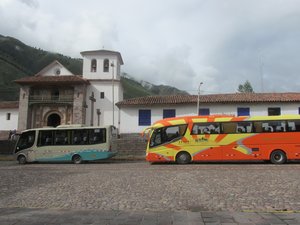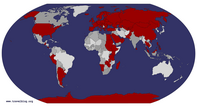Advertisement
Published: February 5th 2016

 Andahuaylillas
Andahuaylillas
My bus dwarfs the Inka ExpressIt was time to leave Cuzco, (Days 13 and 14 were pretty lazy, so nothing to write about) so I did some research and found the Inka Express, which for $50 took you from Cuzco to Puno (on Lake Titicaca) via VIP bus seats and with various cultural stops along the way. It was hard to find their office and they did not respond to my email immediately. So, I asked my hostel to set it up and somehow I got snaked away and put with another company, Wonder Peru Expedition. I didn't realize it until the next day, Day 15, and the confusion I had felt when Inka Express finally returned my email but said I was not in their system was solved. Oh well.
Their bus, and thus group, was smaller so the ride probably would have been more comfortable; as it was, I was sat next to a larger woman who seemed to think that since I was smaller, she was free to occupy 2/3 of the double seat area. That is a huge pet peeve of mine; just because I am smaller, doesn't mean I like having your elbows in my ribs the whole time -
I get this all the time on flights too. People are just so rude. Anyway, while the seats were a problem for me, I absolutely loved our guide, Juan. His English, Quechua and Spanish were fantastic and easy to understand - he switched between them effortlessly. I gave him a nice tip at the end.
I was picked up at my hostel just before 7 that morning and taken to the actual company where a huge orange bus was waiting. A large group of Chinese people were part of our tour, but they confined themselves to the back of the bus - they seemed to be having a grand ole time. The bus was pretty nice actually and I was sat near the front window seat, so the scenery was great. There was a hostess on board who offered drinks throughout the trip and a bathroom, which was convenient but I did not use. The ride was $50, but I had to pay another S/40 (~$13) for entrance fees to some of the locations.
Andahuaylillas Our first stop was the church at Andahuaylillas, approximately 45 km south east of Cuzco, Iglesia de San Pedro. It is the
"Sistine Chapel" of South America, due to its lavish artwork within the church and while it was a bit garish, it was also quite impressive. No pictures were allowed within the church, though they gave cd's with their own photos as we entered. The first stop we made within was an archway covered in pictures and words in various languages - Latin, Spanish, Quechua and Aymara (the two latter being the native languages of the area). There are large gold covered statues throughout and a painted ceiling. The church was constructed from the late 16th century through the early-mid 17th century. The walls are approximately two meters thick, which helps against any seismic activity. Outside there is a small market in the small town square where the locals sell their handicrafts. All in all, an impressive first stop.
Raqchi Our next stop was the village of Raqchi, which is about 125km south east of Cuzco. This was my favorite of the day as there was much to see. I loved driving into the village as the terraced walls had cantilevered large rocks as steps to each terrace at regular intervals. Besides the very cute small town square with
handicrafts all around (I wish I would have bought some of the necklaces!), there are impressive ruins sounding the area. One of the most important and largest temples of the Incan empire, Temple of Viracocha, is located just outside the town walls. The height of the main temple was about 16m high with the largest roof of the empire spreading down to the sides and supported by 22 columns, 11 on each side; the columns were destroyed by the spanish invaders, but you can still see their foundations.
The other impressive Incan feature is the ruins of 156 storehouses. One thing I learned back from the exhibition in DC (Museum of the American Indian - Inca Road) was how the Incan Empire operated. First of all, the Incans were basically the royalty of the area; they conquered the local peoples just as the Spanish conquered them. In this part of the empire, the local people were the Quechuas, which also became the language of the Incas. Despite being conquerors, the Incans were actually surprisingly fair and concerned for the well being of their people. They had a kind of reciprocity system where each person had to spend a certain
amount of time each year in the service of the empire to help the greater good (i.e. maintaining/constructing roads and bridges). In addition, they paid taxes in the form of crops and livestock. These storehouses contained the various collected taxes for the use in times of need. If there was a heavy El Nino event or a long term drought, this food was distributed amongst the people. I find this system quite impressive. While the large temple was unique, there were various locations where the storehouses were collected amongst the empire.
Sacuani Not much to say here except that we stopped at a place randomly located on the road near the village of Sacuani where we had our lunch. It was a self serve buffet with various types of local foods. Pretty good - soup of course, which I skipped. The bathrooms were the best I had seen in a while. And it was quite picturesque, with a lively alpaca grazing the back and mountains in the distance. Very pleasant.
Abra La Raya The next location stop was at the highest point of our trip - the pass at La Raya, located at approximately 4,470 meters
(~14,600 feet). Just before we got there, we passed a waterfall coming down from the mountains which is the start of the river that runs throughout the Sacred Valley and past Machu Pichu, Rio Urubamba or Rio Vilcanota (the Spanish-ized Quechua name). This is also the location of the administration division between the Cuzco and Puno regions; after this, we were officially in Puno region.
At the pass, there are, of course, lots of local people selling their crafts. Some were quite lovely, but I'm sure the price is jacked up here. Instead, we had a few minutes to take photos of the impressive views. My favorite was seeing the Peru Rail train heading from Cuzco towards Puno against the backdrop of the large mountains. I had looked into taking the train but it was more than $200 compared to my $50; plus I really enjoyed making these various stops and seeing things besides the major tourist points.
Pucara I was a little disappointed at this one as we bypassed the terrace ruins which were set up against a huge cliff face and apparently had been used for ceremonies. These were also NOT Incan ruins, but the
ruins of the Pucara people who flourished between 500 BC and 500 AD. Instead, we continued into town and went to the Museum, which had nice displays of some of the monoliths recovered from the ruins. Like the Incas, the "royalty" or upper class had one job, which was to communicate with the gods, while the rest of the people worked the land. The Pucara people unfortunately went through a huge drought at the end of their reign and they blamed the upper class for it, executing them and dispersing. At least, this is the story Juan told us.
There were also glimpses of Spanish influences. One is of the two bulls that are seen on various roofs throughout Peru, which are supposed to provide protection and prosperity. Apparently, this tradition originated here. This also means that Pucara is well known for their ceramics. The other Spanish influence is the old large church. It was closed when we went, but it seemed to be very down trodden. Indeed, the whole town did. There were lots of beggars who plopped themselves near our bus. There were few people out in the streets otherwise. I wanted to walk up to the
ruins quickly, but the empty streets and bands of large wild dogs made me want to keep nearer to the group. However, I did enjoy many of the streets, which had figures of bulls and monoliths and other animals etched into them. This town really could be quite lovely. Such a shame.
Juliaca Fortunately, we did not stop here. It is a large town (approximately 300,000 people) near Puno which houses the local airport. However, driving into town on the main road, turning onto another main road, reminded me a lot of the Industrial Area in Doha. Gianormous potholes everywhere. Obviously something happened to this street and it has not been fixed as there were cars, buses, trucks, ciclitos, and motorbikes all in the same predicament - just trying to get through a major intersection. Apparently, it is a large commercial area as a crossroads between Bolivia and various districts of Peru. But it looked like a sh*thole.
Puno blog is next…
Advertisement
Tot: 0.093s; Tpl: 0.012s; cc: 14; qc: 28; dbt: 0.0421s; 1; m:domysql w:travelblog (10.17.0.13); sld: 1;
; mem: 1.1mb




















D MJ Binkley
Dave and Merry Jo Binkley
Lucky Bulls
We took several photos of the cute little bulls